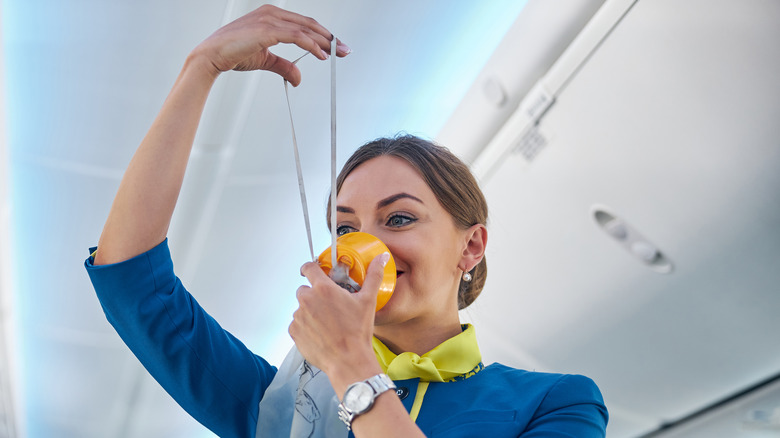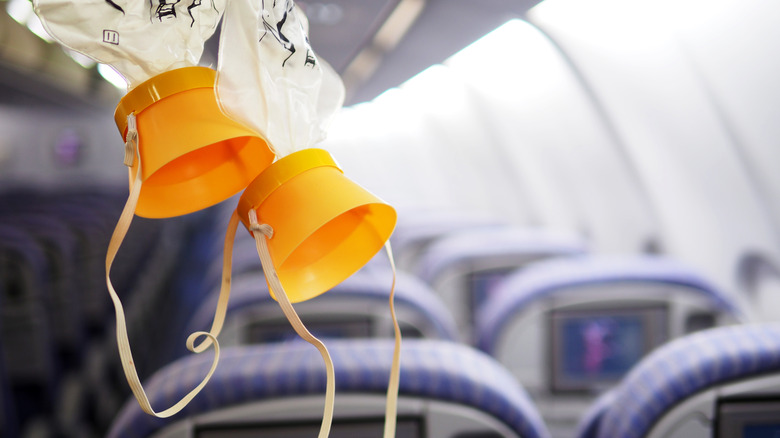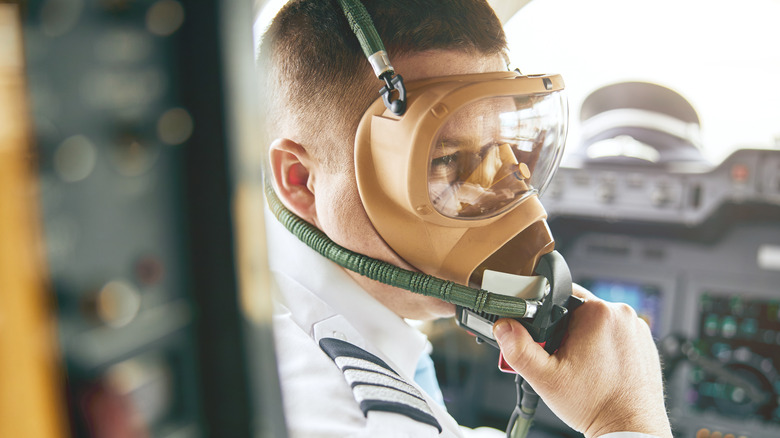What Happens When A Plane Loses Cabin Pressure?
If you fly enough, you're probably not too riveted by the pre-flight safety demonstration. A procedural must-do of the airline industry, the safety demonstration spends a lot of time on using your air masks. While the following isn't a safety refresher course, we think it's interesting — if nothing else — to expand on why air masks are so important to flight safety.
It's a common misconception that you need air masks due to a lack of oxygen at high altitudes. This isn't really accurate. While there's oxygen at higher altitudes, it's actually the lack of pressure that makes it difficult for us to breathe, as oxygen molecules are too spread out. This is why airplane cabins are pressurized. Typically, when at cruising altitude of 35,000 feet or so, the plane is pressurized to the atmosphere of between 6,000-8,000 feet above sea level, which allows us to breathe relatively normally.
So, what happens when the airplane loses cabin pressure? In short, nothing good. Fortunately, commercial airlines have a number of safety protocols in place to help ensure the safety of crew and passengers in this situation. But, if your plane's cabin loses pressure, two things will drop quickly — the air masks and the airplane.
Grab an air mask and try to stay calm
Typically, an airplane depressurizes due to damage that compromises the plane's airtight seal. If this happens at cruising altitude, you'll only have 1-2 minutes of air before you succumb to hypoxia, or a lack of oxygen. Hypoxia causes memory loss, impaired judgment, and a lack of bodily coordination. You'll also quickly feel euphoric before you lose consciousness, which is one of the reasons safety demonstrations recommend putting on your mask before assisting someone else. When feeling the effects of hypoxia, you won't be too helpful to others.
To prevent hypoxia on commercial flights, air masks automatically drop throughout the plane when the cabin's air pressure drops below the equivalent of 14,000 feet. Air masks drop from the panels above passenger seats, in the lavatory, and in the aisles. The Federal Aviation Administration (FAA) mandates that each mask provide at least 10 minutes of supplemental oxygen to each passenger of the plane. While this may not seem like much, 10 minutes is more than enough time for the next thing that occurs when a cabin loses pressure — the rapid descent of the plane.
Grab an arm rest and try to stay calm
When a cabin depressurizes, pilots must take immediate action to quickly initiate a descent to an altitude that provides the cabin with adequate oxygen, which is below 10,000 feet. From a passenger's perspective, this descent will probably feel like a nightmarish free-fall, but pilots are highly trained to deal with the situation, and the procedure is controlled. In fact, due to the potential effects of hypoxia, the procedure must be memorized without the assistance of a checklist.Airplane pilots also have specialized masks to help prevent any effects of hypoxia.
To lower the plane, the pilot will hit maximum speed, set the engines to idle, and then deploy speed brakes to quicken the descent rate. So, yeah, as a passenger, the descent won't seem pleasant (or controlled). The good news is that planes can lose altitude pretty quickly, so your 10 minutes of oxygen offers enough time for breathing (or hyperventilating) while you descend.
Losing cabin pressure while flying is a serious issue. Fortunately, safety protocols are in place to prevent a serious issue from becoming an outright disaster. And cabin depressurization is a rare occurrence, which hopefully allows you to breathe a little easier.


